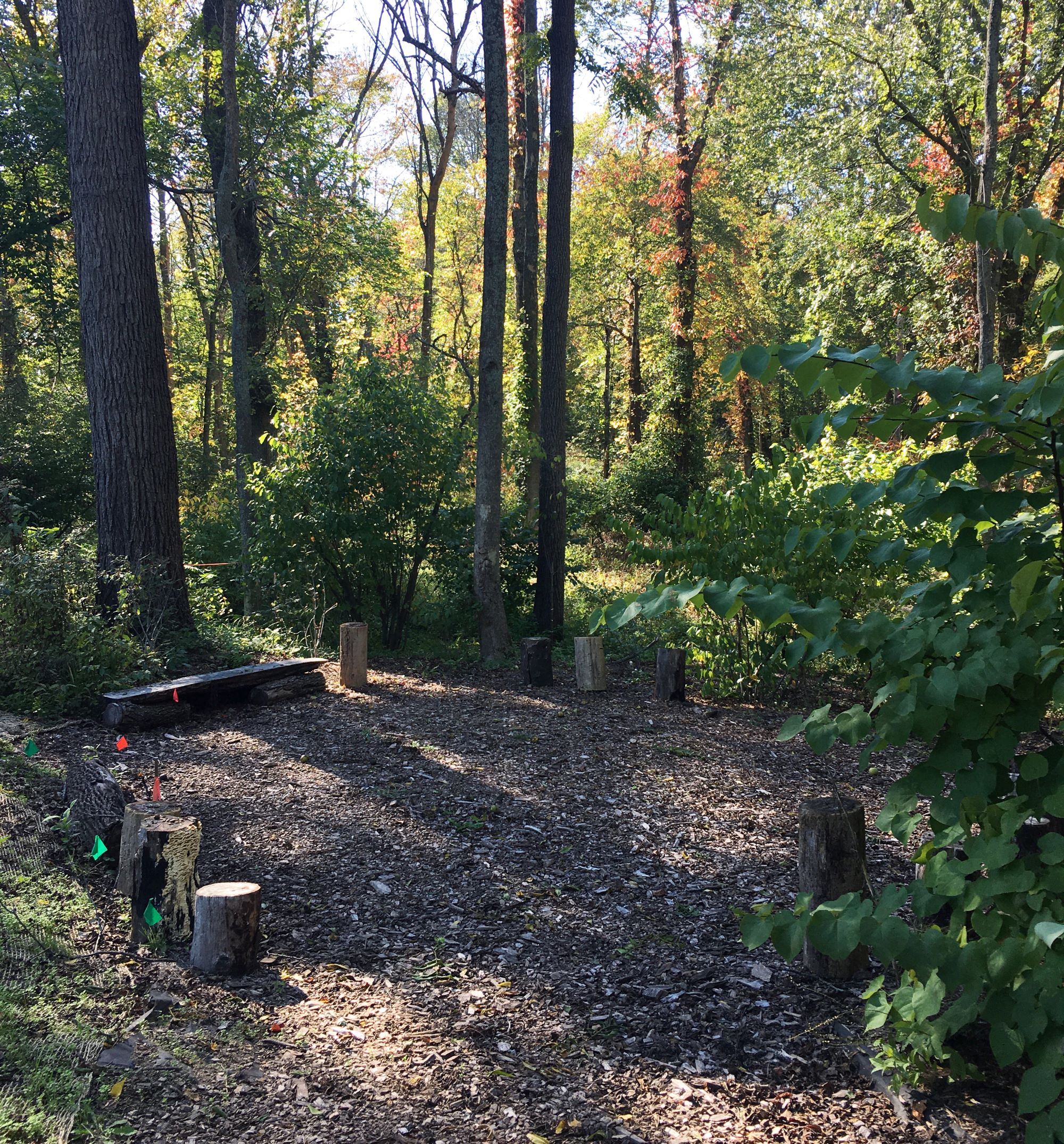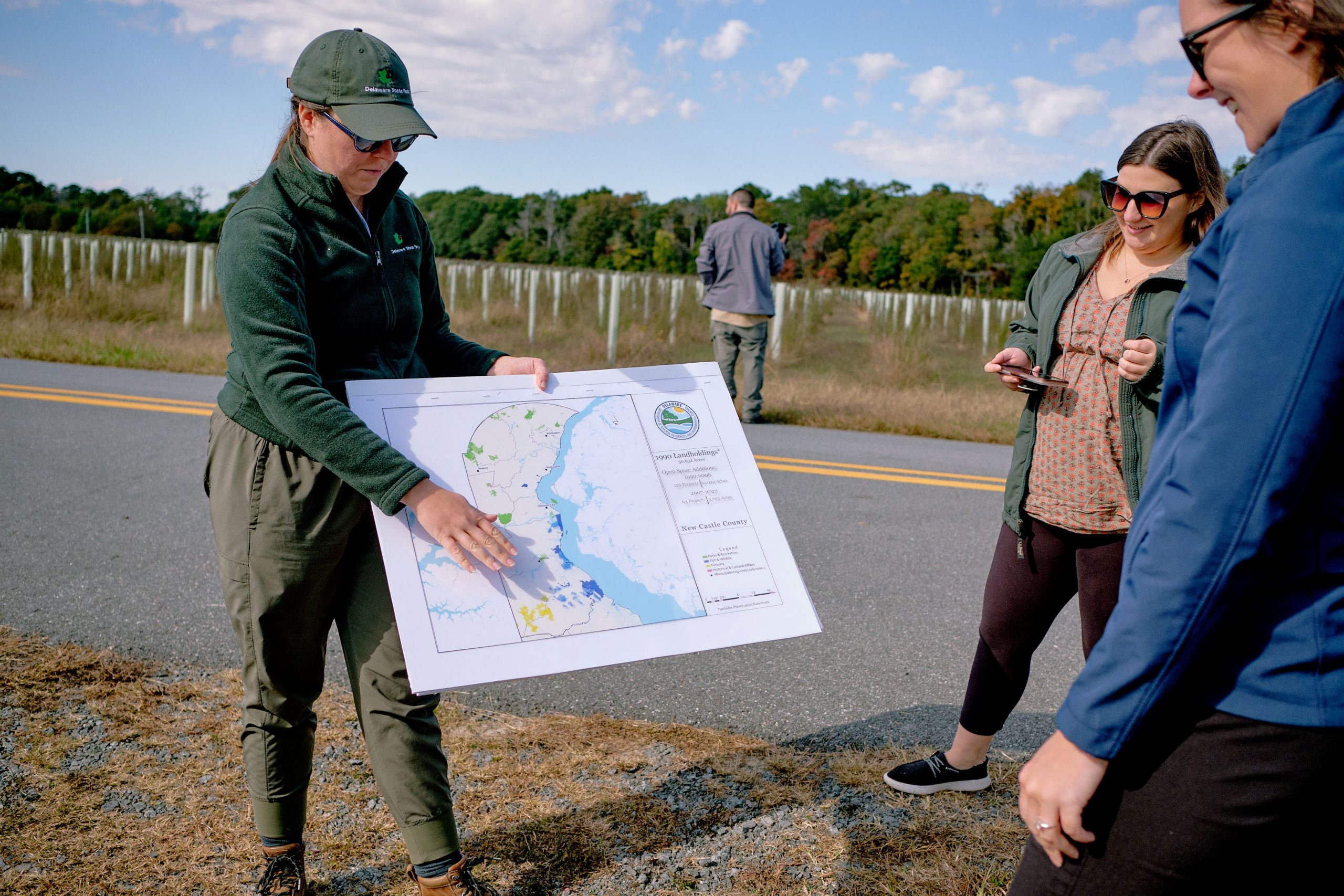By Kerry Batrowny and Craig Rhoads
From the waving marsh grasses along Wilmington’s Riverfront, to the ancient dunes now conserved as part of the nationally renowned Cape Henlopen State Park, the small state of Delaware boasts thousands of acres of unique open spaces.
Created in 1990 by the Delaware Land Protection Act, the Open Space Program is used to acquire new lands, with the goal of providing all Delawareans and visitors with maximum opportunities to enjoy Delaware’s natural and cultural outdoor assets.
Today, the Department of Natural Resources and Environmental Control owns or manages nearly 45,000 acres statewide that have been purchased using a combination of state, federal and partner funds under the Open Space Program.
For Outdoor Delaware, we offer a tour of a few of these diverse properties.
 Along a busy road in north Dover, peace awaits amidst towering trees just a few feet from the asphalt. A circle of stones and stumps that almost blends into the forest floor marks a gathering place — known as a “conversation circle” — for members of the Lenape Indian Tribe of Delaware.
Along a busy road in north Dover, peace awaits amidst towering trees just a few feet from the asphalt. A circle of stones and stumps that almost blends into the forest floor marks a gathering place — known as a “conversation circle” — for members of the Lenape Indian Tribe of Delaware.
Here, work is ongoing to restore, respect and honor the Lenape culture and ancestral rights. Led by Principal Chief Dennis Coker, tribe members have cleaned up, planted native trees and restored a portion of Fork Branch that flows through an area that has been part of their history and culture since before Europeans arrived.
“In our culture, native spirituality emanates from our place, our land. Our connection between this land and our culture is inseparable. That’s why it means so much to us,” says Chief Coker. “Having access to this land gives us the opportunity to delve into that spiritual connection and embolden our culture.”
Chief Coker looks forward to restoring another piece of Lenape ancestral lands: an overgrown property on the opposite side of the road, acquired and restored with the assistance of The Conservation Fund. This valuable land is now protected under a Delaware State Parks Conservation Easement and has been generously donated to the Lenape Indian Tribe of Delaware following the Open Space Council’s recommendation for admittance into the Open Space Program.
Tribe members have begun picking up the trash carelessly tossed from passing cars and cutting out overgrown invasive plants, brush and vines to return the land to its clean and natural state.
Each spring, researchers and bird watchers flock to central Delaware to observe a unique natural phenomenon: the arrival of hundreds of thousands of shorebirds along the Delaware Bay, with Mispillion Harbor at the epicenter of the annual migration.
On their way to their northern nesting grounds, the birds take a rest stop along Delaware’s Bayshore to rest and fuel up before continuing their journey. In nature’s circle of life, their arrival coincides with another annual spring event: horseshoe crabs coming ashore to lay their eggs, which in turn provide protein for the shorebirds’ journey.
At the end of a short residential side road not far from the Bowers Beach Fire Hall and Mispillion Harbor, a quiet stretch of pristine bay beach is now state property. Though small, the Roman-Foley property is important to wildlife conservation efforts by providing additional protected beach for both spawning horseshoe crabs and visiting shorebirds.
Most of the year, the beach is quiet and accessible to visitors, except from mid-April to early June, the time of shorebird migration and horseshoe crab spawning. During this closure, visitors are encouraged to visit the nearby DuPont Nature Center, with its spectacular view of Mispillion Harbor with the birds and horseshoe crabs.
Purchased from private landowners through a U.S. Fish and Wildlife Service Recovery Land Acquisition Grant and the Open Space Program, the beach property was chosen to protect habitat and support migratory shorebirds. These travelers include Rufa red knots, which are listed by the federal government as threatened and by the state of Delaware as endangered.
“Rufa red knots — so named for their rust-red undersides that contrast with their dark-speckled golden backs and black beaks — must refuel to survive their annual 9,000-mile journey to their Arctic nesting grounds,” says Avian Conservation Program Manager Samantha Robinson, DNREC Division of Fish and Wildlife. “For many, the Delaware Bay is their final and most important stopover, supporting up to 50 to 80% of all migrating Rufa red knots on the last leg of their long flight.”
Just outside the quiet town of Dagsboro in Sussex County, a world away from Delaware’s nearby bustling resort beaches, two rural properties were acquired through the Open Space Program for diverse purposes.
With a clause in its deed stipulating the property must be maintained in its natural state in perpetuity, the 52-acre Timmons Property is former farmland that’s being reforested, a DNREC project in partnership with the Center for the Inland Bays to benefit water quality in Indian River Bay and help shore up areas facing climate impacts.
The highly visible reforestation project is a curiosity for passersby: rows of upright white pipes lined up like soldiers in former farm fields.
“We needed a way to keep local deer from eating the young trees,” said Sussex Wildlife Area Manager Rob Gano, DNREC Division of Fish and Wildlife. “We weren’t convinced the trees would grow inside the pipes. But sure enough, you can see the tree tops poking out now. In a few years, we’ll have a young forest here.”
A large saltmarsh area also on the Timmons Property is being conserved to provide much-needed flood mitigation as climate change brings higher tides and more damaging storms to the area.
Nearby, overlooking a tidy waterfront community, the 9-acre Piney Neck Property offers access to Indian River Bay, providing a new low-impact recreational option on the 3,350-acre Assawoman Wildlife Area.
A short walking path from a new parking area takes visitors down to a wooden dock that’s been upgraded to a public access crabbing pier, with a shoreline kayak launch to be added.
The Open Space Program leverages federal and partner funds and with state funds to protect land through fee-simple acquisition or conservation easements. The program also encourages voluntary donations through the promotion of tax benefits.
Working with DNREC, the Department of Agriculture’s Delaware Forest Service and the Department of State’s Division of Historical and Cultural Affairs, the Delaware Open Space Council coordinates acquisition of natural areas, forests, wildlife habitats, greenways and waterways, and works to expand state forests, parks and preserves, fish and wildlife areas, and cultural resource sites.
 Identifying, conserving and maintaining our open spaces is more crucial than ever, and DNREC’s mission includes seeking out and exploring opportunities to protect additional lands for their natural and environmental importance, historic and cultural significance, and recreational use.
Identifying, conserving and maintaining our open spaces is more crucial than ever, and DNREC’s mission includes seeking out and exploring opportunities to protect additional lands for their natural and environmental importance, historic and cultural significance, and recreational use.
Of the nearly 27,000 acres the DNREC Division of Parks and Recreation currently owns and/or manages, close to 16,000 of those acres were acquired through the Open Space Program. The DNREC Division of Fish and Wildlife, meanwhile, owns and/or manages almost 68,000 acres, of which about 29,000 acres have been acquired with the program’s support.
Because of the Open Space Program and its council, generations to come may experience glimpses of the Lenape Indian Tribe’s cultural heritage, of a quiet bay beach mobbed with migratory birds and spawning horseshoe crabs in an age-old spring ritual, of reforested lands and preserved salt marshlands that help absorb flood waters impacting our vulnerable beach fronts — and more.
Kerri Batrowny is a preservation planner for the DNREC Division of Parks and Recreation. Craig Rhoads is a program manager for the DNREC Division of Fish and Wildlife.
Related Topics: conservation, education, history, nature, open space, wildlife